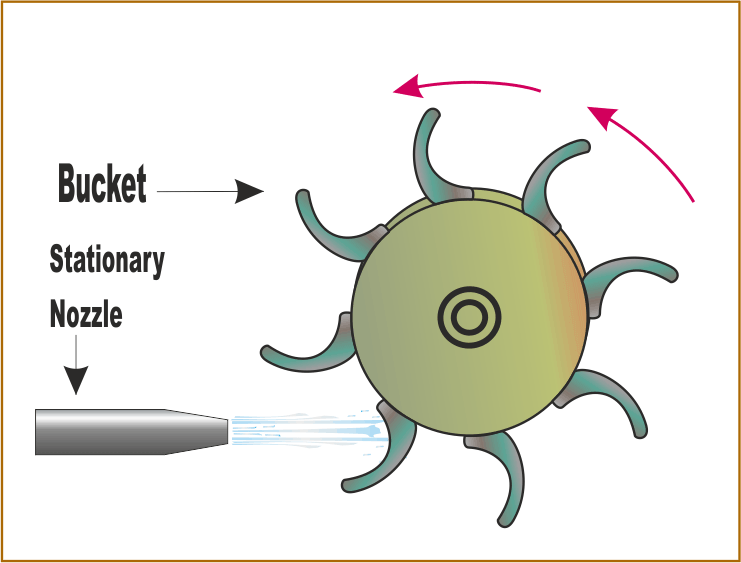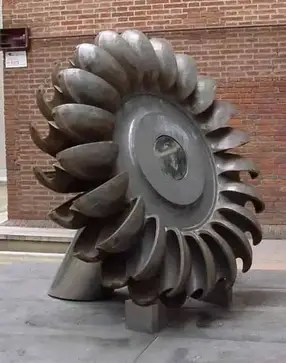IMPULSE STEAM TURBINES
IMPULSE TURBINE: DIAGRAM, WORKING, TYPES, EXAMPLE [PDF]
A turbine is a mechanical device that rotates and produces power. These turbines can be divided according to their uses such as water turbines or hydro turbines, gas turbines, steam turbines, or wind turbines. A hydro turbine can be divided into two groups based on how the force is exchanged within the turbine, such as an impulse turbine and a reaction turbine.
These turbines are primarily used to convert the water supply’s potential and kinetic energy into mechanical work. This article will explain the operation and application of an impulse turbine.
So let’s start with what is a Turbine.
What is a Turbine?
I know you heard about generating electricity from hydropower plants, yes, this is done by turbines. The work produced by a turbine can be used for generating electrical power when combined with a generator.


A turbine is a rotary mechanical device that extracts energy from a fluid flow and converts it into useful work by a system of fixed and moving blades causing the wheel to rotate.
Water turbine was developed in the 19th century and was widely used for industrial power prior to electrical grids. Now they are mostly used for electric power generation. They harness a clean and renewable energy source.

You know what makes them so efficient that they are lighting up our houses? An efficient turbine can utilize up to 90% of the water’s potential energy.
Although there are various types of impulse turbines available, but Pelton wheel turbine is the most widely used impulse turbine. We can generate a maximum of up to 200 MW of electricity from a Pelton wheel turbine, where we have a water head (height of stored water), as high as one thousand meters.
Let’s now explore what an impulse turbine is and what it does.
What is an Impulse Turbine?
An impulse turbine changes the velocity of a water jet. The jet impinges on the turbine’s curved blades which change the direction of the flow.
The resulting changes in momentum (impulse) cause a force on the turbine blades. Since the turbine is spinning, the force acts through a distance (work), and the diverted water flow is left with diminished energy.
The water pressure (potential energy) is transformed by a nozzle into kinetic energy before striking the turbine blades. No pressure change occurs at the turbine blades, and the turbine doesn’t require housing for operation.
Newton’s second law describes the transfer of energy for impulse turbines. Impulse turbines are most often used in very high-head applications.
A difference between an impulse turbine and a reaction turbine is that, in an impulse turbine, all the hydraulic power in the water is converted into kinetic energy using nozzles without any force changes. In a reaction turbine, however, only some of the available energy is converted into kinetic energy.
Read Also: 19 Different Types of Valves Explained [Pictures & Uses]
Parts of Impulse Turbine
There are various parts that can be used to build an impulse turbine. Thus, the primary parts of an impulse turbine are;
- Penstock
- Nozzle
- Runner or impeller
- Bucket
- Casing
- Braking jet
- Spear

#1 Penstock
In hydropower plants, penstocks are pipes and channels. These transport water to turbines from dams and reservoirs. Because the reservoir is at the top end and the turbine is at the bottom. Steel is used to make penstocks. These ducts have high-pressure water flowing through them.
#2 Nozzle
The primary purpose of the nozzle is to provide water to the impeller blades. It is the single component of the impulse turbine assembly where the energy is from the flow head. It converts the pressure energy to kinetic energy. When this conversion occurs, it increases the kinetic energy of water when it hits the impeller blades.
#3 Runner or Impeller
The runner has the form of a circular disk that is mounted on a rotating shaft known as a rotor. Stainless steel is commonly used for shafts and runners. On the runner, which is uniformly curved, the cup-shaped blades (buckets) are also organized on them.
#4 Bucket
A collection of spoon-shaped cups fixed around the runner is called a bucket. It transfers energy from the fluid to the turbine. These buckets are built from cast iron or stainless steel.
When the water jet leaves the nozzle, it hits the buckets in the turbine, turning it and removing the external bucket edge. In comparison to the impact angle, the fluid direction will alter at the departure depending on the turbine design.
This angle needs to be 180 degrees to gain significant energy. However, in this case, the angle is limited to 170 degrees since the exit flow from one bucket does not crash into or break the following bucket.
#5 Casing
An impulse turbine casing acts as a shield for the turbine. This shield protects against water splatter and directs the spillway channel so that water does not disperse. Additionally, it protects all of the turbine’s parts from the outside environment. This shield of protection is composed of cast iron.
#6 Braking Jet
The braking jets prevent the blades of the turbines from damaging themselves once the water flow is turned off. It is possible to stop the water supply to the turbine, but the blades will still rotate. As a result, the turbine blade will strike from the opposite side of the blade, preventing the turbine blade from spinning quickly.

#7 Spear
In the turbine, the spear structure has a conical shape. It is attached to the nozzle so that it may control the flow of water into and out of the nozzle as well as strike the bucket.
Read also: What is a reciprocating pump and its working principle
Working Principle
The water flows along the tangent to the path of the runner. Nozzle direct forceful streams of water against a series of buckets mounted around the edge of a wheel. As water flows into the bucket, the direction of the water velocity changes to follow the contour of the bucket.

When the water jet contacts the bucket, the water exerts pressure on the bucket, and the water is decelerated as it does a “u-turn“ and flows out the other side of the bucket at low velocity.
In the process, the water’s momentum is transferred to the turbine This “impulse “ does work on the turbine. For maximum power and efficiency, the turbine system is designed such that the water-jet velocity is twice the velocity of the bucket.
because water and most liquids are nearly incompressible, almost all of the available energy is extracted in the first stage of the hydraulic turbine. Therefore, the Pelton wheel has only one turbine stage, unlike gas turbines that operate with a compressible fluid.
Read Also: Understand The Different Types of Flow Control Valves
Types of Impulse Turbine
The most common types of water turbines used in hydropower plants are:
#1 Pelton Turbine

This kind of impulse turbine is the most popular one. The Pelton turbine is made up of three major components: the nozzle, the runner, and the deflector. There are two cups in every bucket with splitters arranged between the double cups.
This turbine provides the water flow between the two cups to improve turbine performance. Pelton turbines have an efficiency of up to 95%, while micro-level hydroelectric facilities have an efficiency of up to 90%. Pelton turbines are the best choice for tiny volumes of water and very high heights (80 to 1000m).
Features:
- It is used for heads ranging from 20 meters to hundreds of meters with discharge rates ranging from 5 to 1000 liters per second.
- Installation of a Pelton turbine is typically simpler than a reaction turbine, such as a Kaplan, with comparable power. This is because the pipe requirements are less due to the flow rates.
- These turbines need complex and expensive equipment for the penstock since the Pelton turbine operates best at high water pressures.
#2 Turgo Turbine

Turgo turbines operate similarly to Pelton turbines, but the water jet hits the buckets obliquely (about 20 degrees). The buckets of these types of turbines are more difficult to manufacture because of their intricate shape.
Compared to Pelton, the Turgo turbine has a higher specific speed. When compared to Pelton, this turbine has a greater jet and a smaller machine size. Small hydropower plants employ this particular type of impulse turbine.

Features:
- Typically, this turbine produces high flow rates.
- It is generally suitable for high speed.
- This turbine can handle a lot of water flow.
- Assembly is straightforward.
#3 Cross-Flow Turbine

The first cross-flow turbine was developed in 1903 by Donnet Banki, Fritz Osberg, & Anthony Michel. These specialized impulse turbines are used in small hydropower facilities. These turbines have very simple designs but require very little maintenance.
These turbines supply water across the turbine blades or through the turbine, whereas other turbines supply water radially or axially.
Features:
- This turbine can handle flows of 20 to 2000 liters per second with a head of 2 to 200 meters.
- These turbines can produce electricity in the range of 5 kW to 100 kW for hydro sites with standard power output and up to 3 MW for big systems.
- They require almost no maintenance and are simple to construct.
Read Also: Everything You Need To Know About Properties of Fluids
Advantages
The following are some advantages of an impulse turbine:
- Simple in construction and easy to maintain.
- This turbine has high efficiency.
- They work at atmospheric pressure so no problem of leakage.
- It is easy to assemble.
Disadvantages
The following are some disadvantages of impulse turbines:
- This is not the best turbine for low-pressure streams with a high flow rate.
- Impulse turbines are large in size compared to others.
- Efficiency decreases with time.
- It is costly to install.
- It is appropriate for low discharge.
Application
The following are a few applications for impulse turbines:
- Impulse turbines are employed in water delivery systems.
- These are most typically found in hydroelectric plants.
- This type of turbine is used to produce electricity.
Final Thought
That’s it. Thanks for reading. I hope I have covered everything about the “Impulse Turbine.” It would be helpful if you could let me know if there was anything I missed or if you have any doubts about anything I wrote.
Please share this article with your friends if you find it interesting.
Want free PDFs direct to your inbox? Then subscribe to our newsletter.
Download PDF of this article:
You might like to read more in our blog:
- What is Fluid? Different Types of Fluids in Fluid Mechanics
- Different Types of Essential Plumbing Tools used in Plumbing
- Different Types of Pneumatic Valves & Their Applications
External Links:

